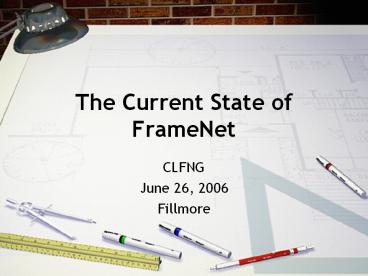The Current State of FrameNet - PowerPoint PPT Presentation
Title:
The Current State of FrameNet
Description:
for specialist vocabulary nobody doubts the need of such background ... support verbs or prepositions with dependent frame-bearing nouns ... – PowerPoint PPT presentation
Number of Views:29
Avg rating:3.0/5.0
Title: The Current State of FrameNet
1
The Current State of FrameNet
- CLFNG
- June 26, 2006
- Fillmore
2
The Starting Challenge
- A standard dictionary often does not give us
- the background to the meanings of words
- for specialist vocabulary nobody doubts the need
of such background - frame semantics proposes that ALL (content)
words, including the ones that everybody knows,
are best understood in terms of their background
frames - a description of a words combinatory affordances
(valences) - this requires a description of the elements of
each frame the things that can be relevantly
talked about within phrases structurally related
to the word being described and a
classification of relevant syntactic forms and
functions - examples illustrating its common uses
- and these should be determined from examples from
a large corpus
3
The Starting Solution
- Describe a situation type (frame) that holds for
one or more words in the language. - Revenge
- Find the frame elements for this frame.
- Avenger, Offender, Injury,Injured_Party,
Punishment - Choose words that belong to the frame.
- avenge, retaliate
- Create valence descriptions as sets of triples
frame elements, grammatical function, phrase
type for each word. - one possibility for avenge
- Av,Subj,NP, Inj,Obj,NP, Pun, Dep,
PPingby
4
Do this by
- Having trained humans annotate good example
sentences by assigning FE labels to the syntactic
dependents of words being described. - Having automatic processes assign syntactic form
and function properties to the labeled phrases. - Having automatic processes derive the valences
from the annotations. - Noticing whether the number of syntactic phrases
found with the head word matches the number of
frame elements known to belong to the frame, and
figure out what to make of discrepancies when you
find them.
5
The Product
- Frame Descriptions
- Lexical Entries specifying
- frame membership
- valences
- access to examples
- Annotated Sentences
- Map of Frame-to-Frame Relations
6
Immediately Emerging Issues
- For our lexicographic purposes we wanted to
select only simple clear examples. - First, thats not possible.
- Second, we need to be able to annotate full
texts. - There are cases where the major frame in a
construction was evoked by a syntactic dependent,
not a syntactic head - support verbs or prepositions with dependent
frame-bearing nouns - say a prayer, swear an oath, make a promise
- transparent nouns selected by their complements
(unitizers, etc.) - stick of gum, kernel of rice,
- There are cases of mismatches between the number
of syntactic constituents we find in a sentence
and the number of frame elements that we might
expect to see represented. For example - null representation of some FEs (for which we
have stories) - multiple or discontinuous representations of some
FEs
7
More Recently Emerging Issues
- Not all FE are of equal status. We proposed
distinguishing - Core,
- Peripheral and
- Extrathematic FEs,
- if only because we wanted to say SOMETHING about
all phrases that were in syntactically
appropriate positions relative to each target LU. - We bombed their village yesterday in retaliation.
- The set of frames is not a flat list. There are
frame-to-frame relations, of various kinds,
importantly - inheritance
- composition
- perspective
8
Issues that dont go away
- Public Relations
- Some of our lexicography and NLP friends object
that since we work one frame at a time,rather
than one word at a time, itll take forever
before we can provide the research community with
any serious kind of systematic polysemy analysis
hence were useless for WSD. - Speed
- Well always be slow, but a current grant
providing collaboration with Adam Killgarriff and
the use of his WordSketch tool for FrameNet
vanguarding shows promise. (Vanguarding is what
you do before you turn material over to the
annotators selecting correct senses of
polysemous words, sorting and selecting samples
that can together show the variety of syntactic
patterns found with a given word, choosing the
most relevant collocations, etc.. Collin will
talk about this.)
9
Continuing Ambitions
- A speeding up of the whole process (the
WordSketch connection) - Collaborative alignment with WordNet and SUMO
- Full sample FN analysis of some portions of the
ANC - Some open-source way of enhancing the growth of
the FrameNet lexicon - Success in funding 1-4.
10
Current FN Visitors
- Carlos Subirats
- Jan Scheffsczyk
- Thomas Schmidt
- Kyoko Hirose
- Fran Valverde































